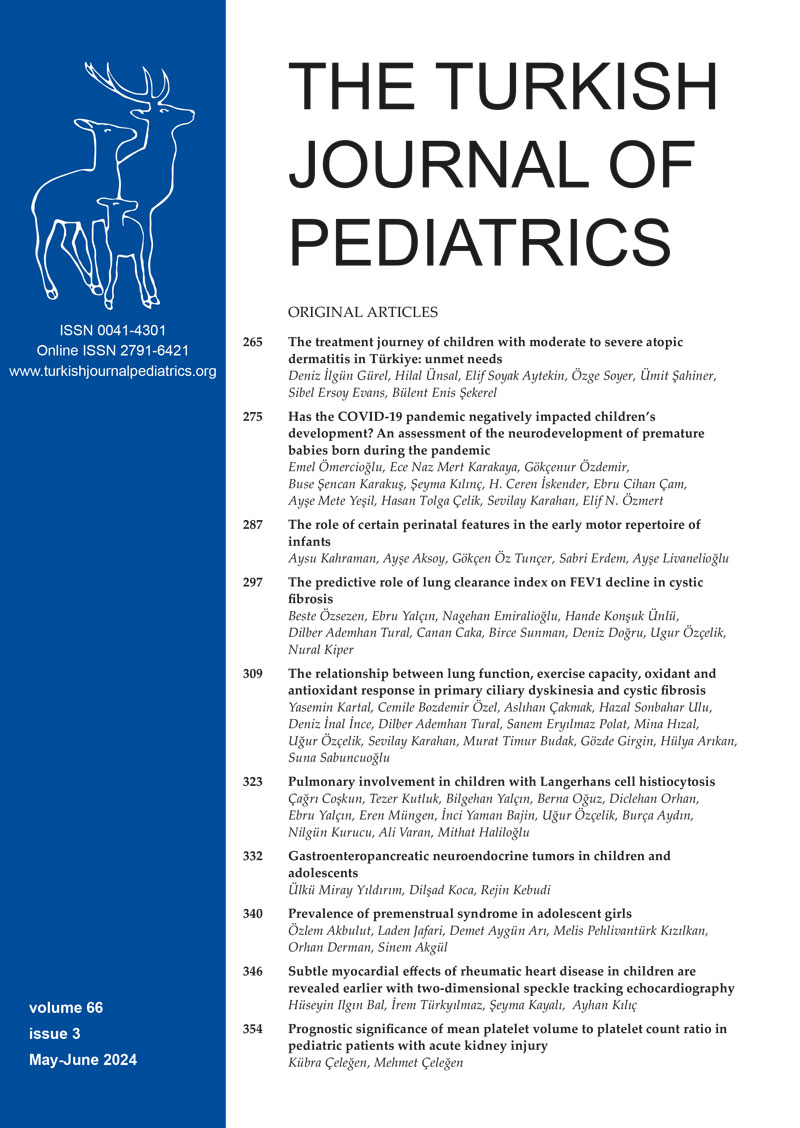Abstract
Background. Premenstrual syndrome (PMS) is characterized by physical, cognitive, emotional, and behavioral symptoms that appear during the luteal phase of the menstrual cycle, disappear after menstruation, and are recurrent in every cycle. PMS significantly affects the social and academic lives of adolescents, and historically, it has been neglected by healthcare professionals. We aimed to evaluate the current point prevalence of PMS in Turkish adolescents presented to a tertiary adolescent medicine clinic.
Material and Method. Adolescent girls between the ages of 12 and 18 and who had regular menstrual cycles for at least three months without any mental or chronic illness were assessed. A clinic information form and the ‘Premenstrual Syndrome Scale’ (PMSS) questionnaire were completed. Those with a PMSS total score of more than 50% of the total score (>110 out of 220) were classified as PMS (+). Those classified as PMS were further classified as mild-moderate (score: 110-150) and severe (>150).
Results. The study included 417 adolescents. The point prevalence of PMS was found to be 61.2% (n:255). Of those with PMS, 49.4% had mild-moderate and 50.6% had severe PMS. The mean PMSS score was 154.56 ± 30.43 in the PMS group and 76.17 ± 20.65 in the non-PMS group (p<0.001). The mean age was 15.41 ± 1.3 years in the PMS group and 14.88 ± 1.35 years in the non-PMS group (p=0.029). None of the youth in our study applied to our clinic due to any premenstrual complaints.
Conclusion. PMS is frequently observed in youth, as indicated by our study. Adolescents have little awareness of PMS and their need for healthcare services. During the evaluation of adolescents, it is important for health care providers to acquire knowledge regarding the features of menstrual cycles and conduct a comprehensive psychosocial assessment.
Keywords: adolescent health, adolescent girls, premenstrual syndrome, prevalence
References
- Vichnin M, Freeman EW, Lin H, Hillman J, Bui S. Premenstrual syndrome (PMS) in adolescents: severity and impairment. J Pediatr Adolesc Gynecol 2006; 19: 397-402. https://doi.org/10.1016/j.jpag.2006.06.015
- Aşcı Ö, Kahyaoğlu Süt H, Gökdemir F. Prevalence of premenstrual syndrome among university students and risk factors. Journal of Dokuz Eylül University Nursing Faculty 2016; 9: 79-87.
- Türkçapar AF, Türkçapar H. Diagnosis and treatment of premenstrual syndrome and premenstrual dysphoric disorder: a review. J Clin Psy 2011; 14: 241-253.
- Yonkers KA, Simoni MK. Premenstrual disorders. Am J Obstet Gynecol 2018; 218: 68-74. https://doi.org/10.1016/j.ajog.2017.05.045
- Grady-Weliky TA. Clinical practice. Premenstrual dysphoric disorder. N Engl J Med 2003; 348: 433-438. https://doi.org/10.1056/NEJMcp012067
- Çelik A, Uskun E. Prevalance of premenstrual syndrome and it’s relationship of quality of life: a community-based study example. Pamukkale Medical Journal 2022; 15: 1-13. https://doi.org/10.31362/patd.872379
- Direkvand-Moghadam A, Sayehmiri K, Delpisheh A, Kaikhavandi S. Epidemiology of premenstrual syndrome (PMS)- a systematic review and metaanalysis study. J Clin Diagn Res 2014; 8: 106-109. https://doi.org/10.7860/JCDR/2014/8024.4021
- Neinstein LS. Adolescent health care: a practical guide. 7th ed. Katzman DK, editor. Philadelphia, PA: Lippincott Williams & Wilkins; 2008.
- Guvenc G, Kilic A, Akyuz A, Ustunsoz A. Premenstrual syndrome and attitudes toward menstruation in a sample of nursing students. J Psychosom Obstet Gynaecol 2012; 33: 106-111. https://doi.org/10.3109/0167482X.2012.685906
- Derman O, Öksüz Kanbur N, Erdoğan Tokur T, Kutluk T. Premenstrual syndrome and associated symptoms in adolescent girls. Eur J Obstet Gynecol Reprod Biol 2004; 116: 201-206. https://doi.org/10.1016/j.ejogrb.2004.04.021
- Gençdoğan B. A new scale for premenstrual syndrome. Psychiatry in Türkiye 2006; 8: 81-87.
- Akgül S, Kanbur N. Premenstrual disorder and the adolescent: clinical case report, literature review, and diagnostic and therapeutic challenges. Int J Adolesc Med Health 2015; 27: 363-368. https://doi.org/10.1515/ijamh-2014-0051
- Appleton SM. Premenstrual syndrome: evidence-based evaluation and treatment. Clin Obstet Gynecol 2018; 61: 52-61. https://doi.org/10.1097/GRF.0000000000000339
- Liu X, Liu ZZ, Yang Y, Jia CX. Prevalence and associated factors of premenstrual syndrome in chinese adolescent girls. Child Psychiatry Hum Dev Forthcoming 2023. https://doi.org/10.1007/s10578-023-01624-8
- Yi SJ, Kim M, Park I. Investigating influencing factors on premenstrual syndrome (PMS) among female college students. BMC Womens Health 2023; 23: 592. https://doi.org/10.1186/s12905-023-02752-y
- Babapour F, Elyasi F, Shahhosseini Z, Hosseini Tabaghdehi M. The prevalence of moderate-severe premenstrual syndrome and premenstrual dysphoric disorder and the related factors in high school students: a cross-sectional study. Neuropsychopharmacol Rep 2023; 43: 249-254. https://doi.org/10.1002/npr2.12338
- Erbil N, Yücesoy H. Premenstrual syndrome prevalence in Turkey: a systematic review and meta-analysis. Psychol Health Med 2023; 28: 1347-1357. https://doi.org/10.1080/13548506.2021.2013509
- Emans SJ, Laufer MR, Goldstein DP. Premenstrual syndrome. In: Pediatric and Adolescent Gynecology. 5th ed. Philadelphia, PA: Lippincott-Raven Inc; 2005: 461-467.
- Halbreich U, Petty F, Yonkers K, Kramer GL, Rush AJ, Bibi KW. Low plasma gamma-aminobutyric acid levels during the late luteal phase of women with premenstrual dysphoric disorder. Am J Psychiatry 1996; 153: 718-720. https://doi.org/10.1176/ajp.153.5.718
- Schmidt PJ, Martinez PE, Nieman LK, et al. Premenstrual dysphoric disorder symptoms following ovarian suppression: triggered by change in ovarian steroid levels but not continuous stable levels. Am J Psychiatry 2017; 174: 980-989. https://doi.org/10.1176/appi.ajp.2017.16101113
- Mohammed S, Larsen-Reindorf RE. Menstrual knowledge, sociocultural restrictions, and barriers to menstrual hygiene management in Ghana: evidence from a multi-method survey among adolescent schoolgirls and schoolboys. PLoS One 2020; 15: e0241106. https://doi.org/10.1371/journal.pone.0241106
- Olson MM, Alhelou N, Kavattur PS, Rountree L, Winkler IT. The persistent power of stigma: a critical review of policy initiatives to break the menstrual silence and advance menstrual literacy. PLOS Glob Public Health 2022; 2: e0000070. https://doi.org/10.1371/journal.pgph.0000070
- Ndayishimiye P, Uwase R, Kubwimana I, et al. Availability, accessibility, and quality of adolescent Sexual and Reproductive Health (SRH) services in urban health facilities of Rwanda: a survey among social and healthcare providers. BMC Health Serv Res 2020; 20: 697. https://doi.org/10.1186/s12913-020-05556-0
- Itriyeva K. Premenstrual syndrome and premenstrual dysphoric disorder in adolescents. Curr Probl Pediatr Adolesc Health Care 2022; 52: 101187. https://doi.org/10.1016/j.cppeds.2022.101187
Copyright and license
Copyright © 2024 The Author(s). This is an open access article distributed under the Creative Commons Attribution License (CC BY), which permits unrestricted use, distribution, and reproduction in any medium or format, provided the original work is properly cited.















